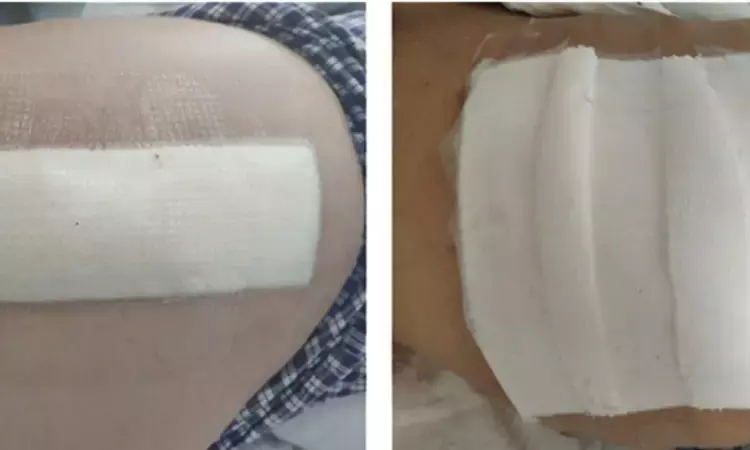- Home
- Medical news & Guidelines
- Anesthesiology
- Cardiology and CTVS
- Critical Care
- Dentistry
- Dermatology
- Diabetes and Endocrinology
- ENT
- Gastroenterology
- Medicine
- Nephrology
- Neurology
- Obstretics-Gynaecology
- Oncology
- Ophthalmology
- Orthopaedics
- Pediatrics-Neonatology
- Psychiatry
- Pulmonology
- Radiology
- Surgery
- Urology
- Laboratory Medicine
- Diet
- Nursing
- Paramedical
- Physiotherapy
- Health news
- Fact Check
- Bone Health Fact Check
- Brain Health Fact Check
- Cancer Related Fact Check
- Child Care Fact Check
- Dental and oral health fact check
- Diabetes and metabolic health fact check
- Diet and Nutrition Fact Check
- Eye and ENT Care Fact Check
- Fitness fact check
- Gut health fact check
- Heart health fact check
- Kidney health fact check
- Medical education fact check
- Men's health fact check
- Respiratory fact check
- Skin and hair care fact check
- Vaccine and Immunization fact check
- Women's health fact check
- AYUSH
- State News
- Andaman and Nicobar Islands
- Andhra Pradesh
- Arunachal Pradesh
- Assam
- Bihar
- Chandigarh
- Chattisgarh
- Dadra and Nagar Haveli
- Daman and Diu
- Delhi
- Goa
- Gujarat
- Haryana
- Himachal Pradesh
- Jammu & Kashmir
- Jharkhand
- Karnataka
- Kerala
- Ladakh
- Lakshadweep
- Madhya Pradesh
- Maharashtra
- Manipur
- Meghalaya
- Mizoram
- Nagaland
- Odisha
- Puducherry
- Punjab
- Rajasthan
- Sikkim
- Tamil Nadu
- Telangana
- Tripura
- Uttar Pradesh
- Uttrakhand
- West Bengal
- Medical Education
- Industry
New dressing system could reduce number of dressings in enhanced-recovery THA

To improve postoperative rehabilitation and reduce postoperative complications, the concept of enhanced recovery after surgery (ERAS) has gained attention in joint arthroplasty surgery. Wound management is an important part of the perioperative period.
Currently, there is a paucity of recommendations in regards to dressing selection within the ERAS protocol. Pengfei Lei et al devised a new dressing system to accelerate the recovery after total hip arthroplasty (THA).
The authors prospectively enrolled 124 patients who underwent a primary THA. The patients were randomly assigned to the intervention (the new dressing system group) or the control (the traditional gauze dressing) group. After suturing the surgical incision, place the calcium alginate dressing (Algisite M, Smith & Nephew, London, United Kingdom) folded into three layers on the incision; choose 3 or 4 pieces of the semi-occlusive, transparent adhesive film (IV3000, Smith & Nephew) as per the length of the incision to paste and fix. There were no air bubbles between the films and the skin, thus they adhered to the skin. In the control group, after suturing of the surgical incision, the wound was covered with eight layers of aseptic gauze, then one layer of aseptic cotton pad, and finally secured with plastic tape along the long axis of the wound.
All patients should have their dressings changed when the dressing has been soaked through, the dressing has become loose or fallen off, or the patient felt uncomfortable. Patients using the new dressing system were allowed to bath as usual based on their lifestyle except for sub merging wounds and dressings in the water. Patients who had traditional gauze dressing can only brush their bodies 2 weeks following the operation and they are not allowed to take showers or bubble baths to avoid wetting the dressings. All patients' dressings were removed 2 weeks after operation and wounds were evaluated.
The primary outcome measures of this study were numbers of dressing changes, postoperative lengths of stay, wound scores including the Stony Brook Scar Evaluation Scale and ASEPSIS scores and wound-related complications. The secondary outcomes include satisfaction scores, dressing-related costs, and pain and functional recovery scores.
The key findings of the study are:
• The intervention group numbers of dressing changes and postoperative lengths of stay were significantly less than the control group (P < .001, P < .001).
• During the one-month follow-up, the Stony Brook Scar Evaluation Scale in the intervention group was significantly better than that in the control group (P < .001).
• The intervention group satisfaction was significantly higher than that in the control group (P < .001).
• There were no statistically significant differences between the two groups in terms of dressing-related costs and pain and function scores.
The authors concluded that –
“The new dressing system could reduce the number of dressing changes and postoperative lengths of stay and increase patient satisfaction, which can be an ideal adjunct to wound management in enhanced-recovery THA.”
Further reading:
A New Dressing System for Wound in Enhanced-Recovery Total Hip Arthroplasty: A Randomized and Controlled Trial
Pengfei Lei, Da Zhong et al
The Journal of Arthroplasty
MBBS, Dip. Ortho, DNB ortho, MNAMS
Dr Supreeth D R (MBBS, Dip. Ortho, DNB ortho, MNAMS) is a practicing orthopedician with interest in medical research and publishing articles. He completed MBBS from mysore medical college, dip ortho from Trivandrum medical college and sec. DNB from Manipal Hospital, Bengaluru. He has expirence of 7years in the field of orthopedics. He has presented scientific papers & posters in various state, national and international conferences. His interest in writing articles lead the way to join medical dialogues. He can be contacted at editorial@medicaldialogues.in.
Dr Kamal Kant Kohli-MBBS, DTCD- a chest specialist with more than 30 years of practice and a flair for writing clinical articles, Dr Kamal Kant Kohli joined Medical Dialogues as a Chief Editor of Medical News. Besides writing articles, as an editor, he proofreads and verifies all the medical content published on Medical Dialogues including those coming from journals, studies,medical conferences,guidelines etc. Email: drkohli@medicaldialogues.in. Contact no. 011-43720751


